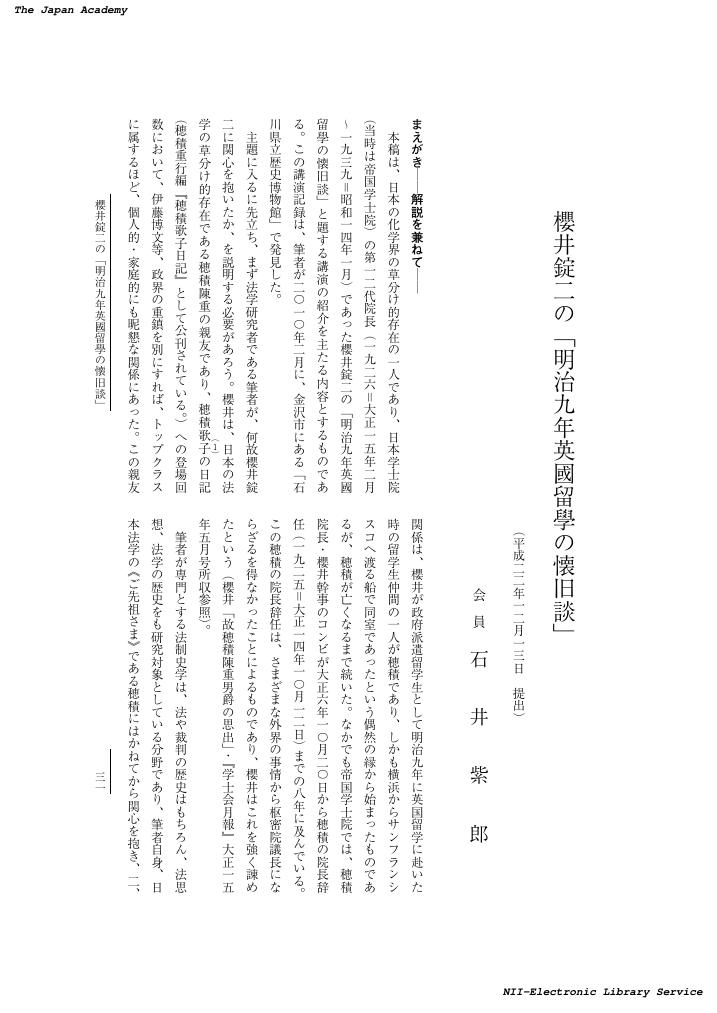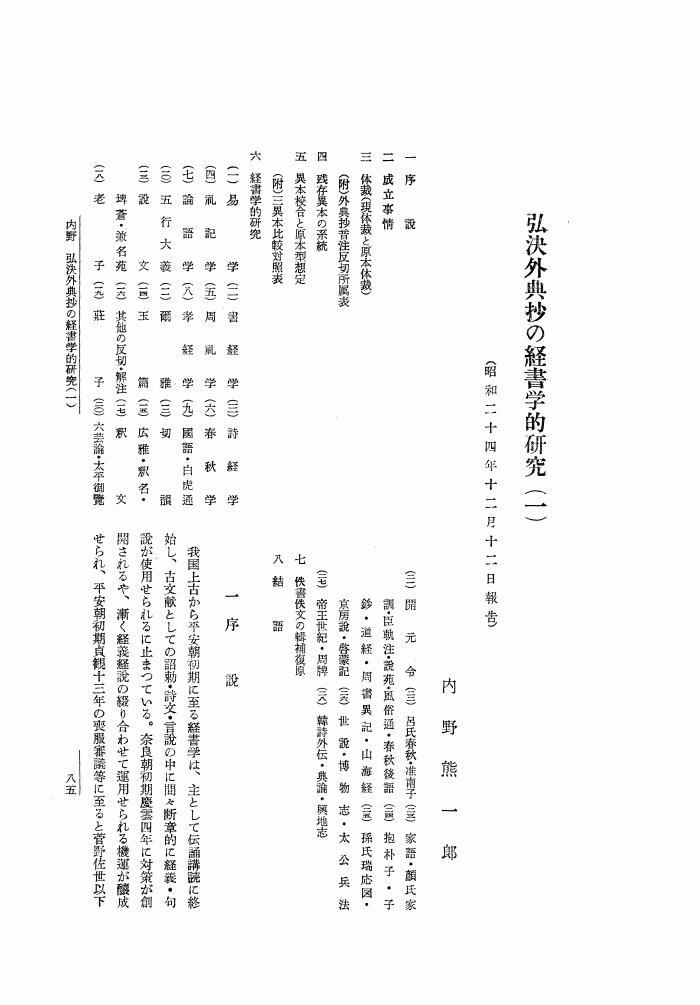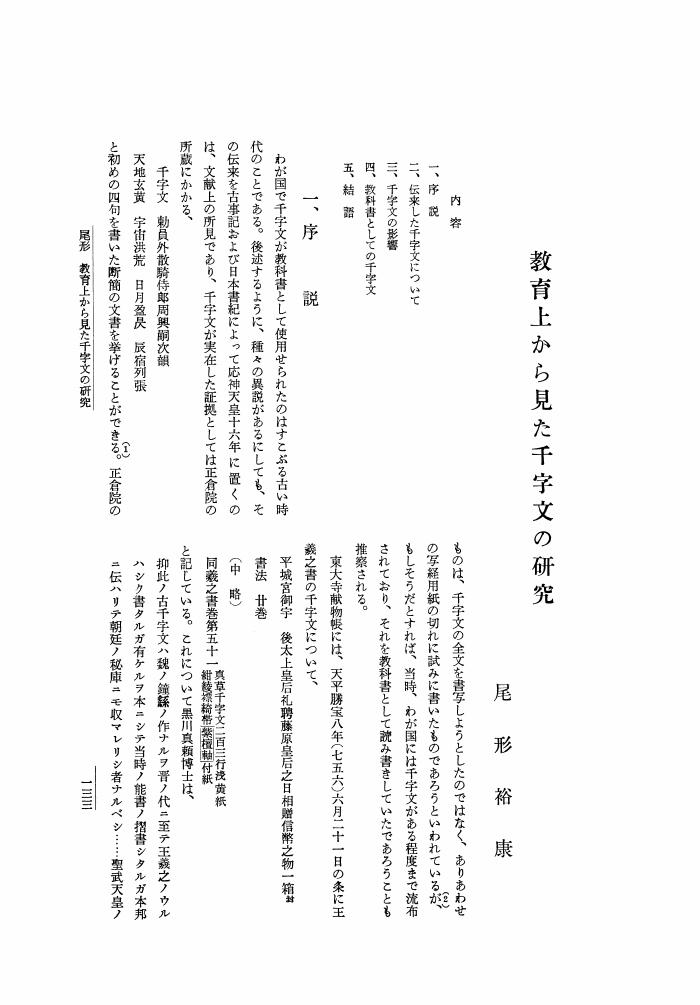1 0 0 0 OA 櫻井錠二の「明治九年英國留學の懐旧談」
- 著者
- 石井 紫郎
- 出版者
- 日本学士院
- 雑誌
- 日本學士院紀要 (ISSN:03880036)
- 巻号頁・発行日
- vol.66, no.1, pp.31-46, 2011 (Released:2017-04-05)
1 0 0 0 初期キリスト教における「神の国」の諸相
- 著者
- 荒井 献
- 出版者
- 日本学士院
- 雑誌
- 日本學士院紀要 (ISSN:03880036)
- 巻号頁・発行日
- vol.74, no.3, 2020
Wie im Judentum des gleichen Zeitalters erwartete auch das frühe Christentum das „Reich Gottes" in seiner Gänze in der fernen Zukunft des Weltendes. Andererseits findet man aber im Neuen Testament den Ausspruch : …das Reich Gottes ist inwendig in euch (Lk 17:21). Dieses Wort ist wahrscheinlich eine Überlieferung, könnte aber auch direkt auf Jesus zurückgehen. Nach dem Evangelisten des ältesten Evangeliums, Markus, steht an erster Stelle von Jesu Mission der Ausspruch : …das Reich Gottes ist herbeigekommen (Mk 1:15), weil die Perfektform dieses Verbs auch die Bedeutungsnuance hat, dass etwas in sehr naher Zukunft geschehen wird. Außerdem sagt Jesus auch : Ich sah wohl den Satanas vom Himmel gefallen als einen Blitz (Lk 10:18). Dieses Wort stammt sicher aus einer visionären Erfahrung Jesu.<br> Wenn dem so ist, dürfte in der neutestamentlichen Wissenschaft der Gegenwart eigentlich keine Übereinstimmung darin bestehen, dass das „Reich Gottes" im Mittelpunkt von jesu Missionsbewegung stand. Man sollte wohl eher annehmen, dass Jesus die Eschatologie des Judentums seiner Zeit, die das „Reich Gottes" in ferner Zukunft erwartete, entmythologisierte und auf den traditionellen allmächtigen Gott des Alten Testaments zurückführte, in dem Gott dem von ihm geschaffenen Menschen im Hier und Jetzt das Leben schenkt.
1 0 0 0 OA 弘決外典抄の経書学的研究 (一) (昭和二十四年十二月十二日報告)
- 著者
- 内野 熊一郎
- 出版者
- 日本学士院
- 雑誌
- 日本學士院紀要 (ISSN:03880036)
- 巻号頁・発行日
- vol.8, no.1, pp.85-154, 1950 (Released:2007-05-30)
1 0 0 0 成年後見制度と高齢者保護
- 著者
- 鈴木 禄彌
- 出版者
- 日本学士院
- 雑誌
- 日本學士院紀要 (ISSN:03880036)
- 巻号頁・発行日
- vol.57, no.1, pp.1-15, 2002
As the elderly increase in the Japanese population, the government, on the one hand, has enacted a series of statutes to provide care for the elderly. Adult Guardian Laws, passed in April 2000, are typical examples of the statutes of this kind. On the other hand, however, the restoration of fiscal balance, the primary objective in the present policy of the Japanese government, causes marked reduction of the budget for elderly care. Perceiving this change of governmental policy, a recent Senryu* verse goes as follows:“Ye elderly, die please-for the sake of thy country”. True to this verse, the elderly will not be able to sustain their lives, if the contemporary fiscal policy is pushed further. One may even say that this policy seeks the demise of Japanese elder generation. How would the government answer this criticism? How should we, the seniors, cope with this present situation? In this paper, I would like to ask this question to my colleagues. *Senryu is a traditional Japanese satirical verse of 17 syllables the genre of which in Edo era.
- 著者
- 鈴木 禄彌
- 出版者
- 日本学士院
- 雑誌
- 日本學士院紀要 (ISSN:03880036)
- 巻号頁・発行日
- vol.55, no.2, pp.67-79, 2000
There have been opposing views on several issues regarding the House Lease Law in recent years. One view is based on the idea that the house lessees are economically disadvantaged people. This idea originates from the miserable life of house lessees in Edo era (referred to as “uratanagari”). It supports the present legal system which provides legal protections for house lessees. The other view challenges this idea and supports a revision of the present legal system aimed at reducing such legal protections. [Chapter 1]<br>With the societal changes that took place in Meiji era, the standard of living of house lessees improved gradually. Furthermore, the Civil Code of 1896 and House Lease Law of 1921 provided several rules for the protection of house lessees. After the revision of the House Lease Law in 1941, it became practically impossible for the owner of a house to terminate the tenant's lease contract without“just cause.”With this revised statute, the agreement of the lease period was practically of no legal effect. [Chapter 2]<br>An improvement of economic conditions in the Postwar Period brought about an elevation in the living standard of house lessees. Against this background, a proposal was made to establish tenancy for a specific number of years. The parties to a house lease contract would agree on the number of years of tenancy. This period would be specified in the contract and the lease would terminate upon its expiration. Accordingly, a“just cause”would not be necessary to terminate the lease. Proponents of this proposal persuaded politicians of the ruling party to back it and succeeded in passing it into law in 1996. [Chapter 3]<br>Under the Japanese Civil Code, the interest of the mortgagee of a real property take priority over that of the lessee if the mortgage is registered before the implementation of the lease contract. There is an exception to this principle in the case of:“short-term leases.”The lessee of a real property who meets certain requirements (as a short-term lessee) need not vacate the leased property even if the mortgage is foreclosed, the property is auctioned, and the vendee demands the lessee to vacate the leased property. Since a short-term lessee is not always a disadvantaged person, the rationale of legal protection for such a lessee is at issue. As this privilege of the short-term lessee is often abused by gangstars and others and causes a disturbance in real estate financing, many influential scholars support its abolition. Others argue, however, that abolishing this privilege would harm the innocent lessees. They are trying to devise compromising solutions. This argument is still unsettled. [Chapter 4]<br>Finally, large construction firms that plan urban redevelopment projects urge landowners to build high-rise buildings on their land, as an investment. Under this scheme, when the landowner builds a building, he leases it to the construction firm. The construction firm, in turn, subleases rooms of the building to sublessees. The difference between the rent paid and earned becomes the profit of the construction firm. In this case, the construction firm is surely a lessee of the building. Therefore, some scholars support the application of the House Lease Law to this type of lease. It is against the spirit of the House Lease Law to allow legal protections to such a big business, however. Thus, more than a few scholars reject the validity of applying this Law to this type of lease. Many cases involving this issue are now under litigation. [Chapter 5]<br>Underlying these various legal issues are opposing ideas as to whether or not it is appropriate to regard house lessees as economically disadvantaged people and allow them legal protections. Finding a settlement to these opposing ideas is the most difficult problem to solve.
1 0 0 0 OA 成年礼の史的考察 表示様式を中心とせる (昭和二十五年三月十二日報告)
- 著者
- 尾形 裕康
- 出版者
- 日本学士院
- 雑誌
- 日本學士院紀要 (ISSN:03880036)
- 巻号頁・発行日
- vol.8, no.3, pp.347-398, 1950 (Released:2007-05-30)
1 0 0 0 邪馬台国はどこか (昭和六十一年十一月十二日 提出)
- 著者
- 服部 四郎
- 出版者
- 日本学士院
- 雑誌
- 日本學士院紀要 (ISSN:03880036)
- 巻号頁・発行日
- vol.42, no.2, pp.93-137, 1987
Firstly, the author agrees with Professor Taro Sakamoto's (M.J.A.) opinion to the effect that the ancestors of the Japanese nation came over to Japan from Siberia via the Mamiya Straits, Sakhalin, and Hokkaido in the early Stone Age. He also approves of Professor T. Sakamoto's theory that <i>Yamatai</i> Queendom was in Kyushu, not in Yamato (Nara Prefecture).<br>The author assumes that the distances described in the so-called <i>Gishi</i> <i>Wajinden</i> are those between the capitals of the kingdoms.<br>The author's hypothetic identification of the capitals of the kingdoms are as follows.<br><i>Matsura</i> Kingdom: Karatsu City including Sakura-no-baba.<br><i>Ito</i> Kingdom: Around the Mikumo-Iwara district in Maebaru Town.<br><i>Fumi</i> Kingdom: Umi City and the adjacent district.<br>As for the capital of <i>Na</i> Kingdom he advances a new theory that it must have been located in the area between Ko-no-su Hills and Mt. Higashi-Abura-yama in Fukuoka City.<br>In regard to <i>Toma</i> Kingdom, the author rejects all the theories advanced so far, and he proposes a new hypothesis that the capital was located around the consecrated spring of <i>Asaduma</i> in Kurume City.<br>The most problematic capital of <i>Yamatai</i> Queendom was located, according to the author, in Kumamoto City.<br>Probably around the end of the 3rd century A.D. it was destroyed to ashes by the Kumaso people (including that of <i>Kuna</i> Kingdom), a branch of the Japanese, who attacked <i>Yamatai</i> Queendom from the south, and the name <i>Yamatai</i> was abolished by them and passed into oblivion.
1 0 0 0 フリーメイソン団成立史研究の現状と論点
- 著者
- 深沢 克己
- 出版者
- 日本学士院
- 雑誌
- 日本學士院紀要 (ISSN:03880036)
- 巻号頁・発行日
- vol.75, no.1, pp.1-25, 2020
I. Introduction: the Japan Academy and Freemasonry<br> Freemasonry, though not well known to Japanese people, is an initiatic society which has played an important part in the formation of modern Occidental civilization since the eighteenth century. So that historical connections are not absent between this fraternal association and the Japan Academy. Firstly, two of the founding members of the Academy, Amane Nishi and Mamichi Tsuda, had been initiated into Freemasonry at Leiden as early as 1864. Secondly, its equivalent in the United Kingdom being the Royal Society of London, the Japan Academy developed exchange, notably after the Second World War, with this British institution whose close relations with Freemasonry were known since its foundation in 1660, starting with Elias Ashmole and Sir Robert Moray. Lastly, just as the Japan Academy maintains intimate relations with the Imperial House, so British Freemasonry has been placed under the protection of the royal family since the early nineteenth century. All this justifies the subject of the present paper.(View PDF for the rest of the abstract.)
1 0 0 0 幕末経済史再考:――手形取引の発展
- 著者
- 石井 寛治
- 出版者
- 日本学士院
- 雑誌
- 日本學士院紀要 (ISSN:03880036)
- 巻号頁・発行日
- vol.74, no.2, 2019
The industrial revolution in Japan in the latter half of the 19th century, the first industrial revolution in Asia, did not depend on foreign capital until 1899, when the Japanese government called off the prohibition on foreign capital investment. This change was a result of Japanese law courts beginning to consider the crimes of foreigners in Japan.<br> Even after 1899, the amount of foreign capital used in private enterprises within Japan was unexpectedly small. In 1914, only 7% of all stocks and debentures of private enterprises were foreign-owned. How did Japanese entrepreneurs then raise money for industrialization?<br> Big enterprises raised money domestically through joint-stock companies. The stockholders invested not only their own money but also money borrowed from banks using their stocks as security. Most stockholders were merchants and financiers, including those who started their businesses in the Edo era. Although the loan business with the merchants set up by the biggest moneychangers, such as Mitsui and Kounoike, was said to be declining toward the end of the Edo era, it is notable that the draft business, which promoted modernization of the economy, was growing.<br> In Japan, payment to distant clients by bills of exchange began in the 13th century, and payment to nearby clients by such bills began in the 17th century. However, Japanese moneychangers did not develop a business around discounting bills because Japanese merchants did not use terminable promissory notes.<br> In this paper, I first discuss cases of settlement of transactions involving cotton goods and fertilizers between Owari (present-day western Aichi Prefecture) and Edo (present-day Tokyo) by bills of exchange. I also discuss cases of settlement for trade of cotton goods and tea between Yokohama and Kamigata (present-day Osaka and Kyoto) by bills of exchange. The latter cases were important in keeping foreign merchants from making inroads into Japan's market. It also led to Japanese merchants accumulating capital via cash payments with foreign merchants in Yokohama.<br> I then discuss cases of settlement among merchants by bills of exchange in Kamigata in the late Edo era. Such settlements became common in Osaka as well as its suburbs, thereby reducing the loan interest rate to approximately 6%, which was almost half of that in Edo.<br> In Osaka, bills of exchange could be settled by many moneychangers who were further controlled by the biggest moneychangers, particularly Kounoike, Mitsui, and Kajimaya. Contrary to popular belief that Mitsui was in financial straits by the end of the Edo era, the real situation of Mitsui was promising when the draft business was taken into account.<br> Although many moneychangers went bankrupt during the Meiji Reform, a considerable number of them survived the phase. Additionally, many powerful newcomers such as Chojiya, Nunoya, and Yasuda began operating during this period. Some of these moneychangers even established modern banks. The most important suppliers of capital for the industrialization in Japan were the merchants, both old and new, headed by moneychangers.
1 0 0 0 OA Q式血液型とその遺伝 (昭和二十四年二月十二日報告)
1 0 0 0 OA デカルトにおける自然学(物理学)の形而上学的基礎づけについて
- 著者
- 小林 道夫
- 出版者
- 日本学士院
- 雑誌
- 日本學士院紀要 (ISSN:03880036)
- 巻号頁・発行日
- vol.71, no.1, pp.1, 2016 (Released:2017-01-20)
1 0 0 0 OA 近江商人の研究 中井家文書を中心として (昭和三十七年四月十二日 会員 本庄栄治郎紹介)
- 著者
- 江頭 恒治
- 出版者
- 日本学士院
- 雑誌
- 日本學士院紀要 (ISSN:03880036)
- 巻号頁・発行日
- vol.20, no.2-3, pp.85-100, 1962 (Released:2007-05-30)
- 著者
- FUNO Shuji
- 出版者
- 日本学士院
- 雑誌
- Proceedings of the Japan Academy. Ser. B: Physical and Biological Sciences (ISSN:03862208)
- 巻号頁・発行日
- vol.93, no.9, pp.724-745, 2017
- 被引用文献数
- 5
<p>Measurement systems are very important in urban design. This article reviews the theories of grid plans, particularly with respect to the spatial formations of ancient capital cities in Asia, and clarifies three Chinese Capital Models. The "Zhōu lǐ" Capital Model (Z) is based on the ancient text "Zhōu lǐ" that makes mention of the ideal city. However, because the description of the physical plan of the city is very brief and includes contradictory elements, conclusions regarding the specifics of the city design are extremely difficult to reach. This article proposes the most appropriate Model (Z) as an architype of the ideal Chinese city. Interestingly, there are no excavated examples of Model (Z). The two existing models, the Chang'an Capital Model (C), which is well known as the model for ancient Japanese capitals like Heiankyo (the present Kyoto) and the Dà Yuán (Dadu) Capital Model (D), the model for the city that is today Beijing, are described as Variants I and II, with a focus on the land division system of <i>bo</i> (street blocks).</p>
1 0 0 0 OA 粟(あわ)鹿(が)大明神元記の研究(二) (昭和三十一年十月十二日紹介)
- 著者
- 是澤 恭三
- 出版者
- 日本学士院
- 雑誌
- 日本學士院紀要 (ISSN:03880036)
- 巻号頁・発行日
- vol.15, no.1, pp.31-73, 1957 (Released:2007-05-30)
- 著者
- 久保 正彰
- 出版者
- 日本学士院
- 雑誌
- 日本學士院紀要 (ISSN:03880036)
- 巻号頁・発行日
- vol.61, no.2, pp.45-64, 2007 (Released:2017-04-05)
1 0 0 0 OA 和算における無限級数概念の生成 (昭和三十四年五月七日 会員 末綱恕一紹介)
- 著者
- 細井 淙
- 出版者
- 日本学士院
- 雑誌
- 日本學士院紀要 (ISSN:03880036)
- 巻号頁・発行日
- vol.17, no.2, pp.179-213, 1959 (Released:2007-05-30)
- 著者
- Niu Kiyoshi
- 出版者
- 日本学士院
- 雑誌
- Proceedings of the Japan Academy. Ser. B: Physical and Biological Sciences (ISSN:03862208)
- 巻号頁・発行日
- vol.84, no.1, pp.1-16, 2008
- 被引用文献数
- 7
This is a historical review of the discovery of naked charm particles and lifetime differences among charm species. These discoveries in the field of cosmic-ray physics were made by the innovation of nuclear emulsion techniques in Japan. A pair of naked charm particles was discovered in 1971 in a cosmic-ray interaction, three years prior to the discovery of the hidden charm particle, J/Ψ, in western countries. Lifetime differences between charged and neutral charm particles were pointed out in 1975, which were later re-confirmed by the collaborative Experiment E531 at Fermilab. Japanese physicists led by K.Niu made essential contributions to it with improved emulsion techniques, complemented by electronic detectors. This review also discusses the discovery of artificially produced naked charm particles by us in an accelerator experiment at Fermilab in 1975 and of multiple-pair productions of charm particles in a single interaction in 1987 by the collaborative Experiment WA75 at CERN.<BR><BR>(Communicated by Toshimitsu YAMAZAKI, M.J.A.)
1 0 0 0 OA 日本古代文学における美の類型
- 著者
- 久松 潜一
- 出版者
- 日本学士院
- 雑誌
- 日本學士院紀要 (ISSN:03880036)
- 巻号頁・発行日
- vol.11, no.2, pp.65-89, 1953 (Released:2007-05-30)
1 0 0 0 OA 教育上から見た千字文の研究
- 著者
- 尾形 裕康
- 出版者
- 日本学士院
- 雑誌
- 日本學士院紀要 (ISSN:03880036)
- 巻号頁・発行日
- vol.11, no.3, pp.133-181, 1953 (Released:2007-05-30)
1 0 0 0 OA 初期キリスト教における「神の国」の諸相
- 著者
- 荒井 献
- 出版者
- 日本学士院
- 雑誌
- 日本學士院紀要 (ISSN:03880036)
- 巻号頁・発行日
- vol.74, no.3, pp.93, 2020 (Released:2020-04-15)
- 参考文献数
- 4
Wie im Judentum des gleichen Zeitalters erwartete auch das frühe Christentum das „Reich Gottes“ in seiner Gänze in der fernen Zukunft des Weltendes. Andererseits findet man aber im Neuen Testament den Ausspruch : …das Reich Gottes ist inwendig in euch (Lk 17:21). Dieses Wort ist wahrscheinlich eine Überlieferung, könnte aber auch direkt auf Jesus zurückgehen. Nach dem Evangelisten des ältesten Evangeliums, Markus, steht an erster Stelle von Jesu Mission der Ausspruch : …das Reich Gottes ist herbeigekommen (Mk 1:15), weil die Perfektform dieses Verbs auch die Bedeutungsnuance hat, dass etwas in sehr naher Zukunft geschehen wird. Außerdem sagt Jesus auch : Ich sah wohl den Satanas vom Himmel gefallen als einen Blitz (Lk 10:18). Dieses Wort stammt sicher aus einer visionären Erfahrung Jesu. Wenn dem so ist, dürfte in der neutestamentlichen Wissenschaft der Gegenwart eigentlich keine Übereinstimmung darin bestehen, dass das „Reich Gottes“ im Mittelpunkt von jesu Missionsbewegung stand. Man sollte wohl eher annehmen, dass Jesus die Eschatologie des Judentums seiner Zeit, die das „Reich Gottes“ in ferner Zukunft erwartete, entmythologisierte und auf den traditionellen allmächtigen Gott des Alten Testaments zurückführte, in dem Gott dem von ihm geschaffenen Menschen im Hier und Jetzt das Leben schenkt.










